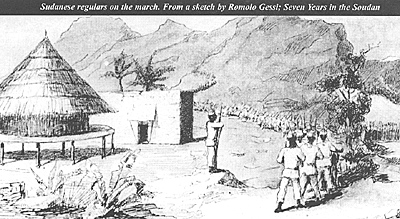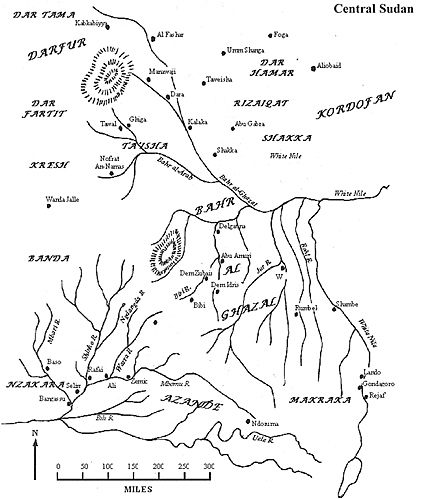 During Zubairís absence in Cairo Rabih was fully engaged in operations in the south of Sudan in the Mbomu river valley. Here he had allied himself with the Azande chief Rafai with whom he continued his slaving operations at the head of 2000 bazingers. During this time, Rabih expanded his regional authority in 1876-77 from a base of 1 Zeriba, with the assistance of 3 others loyal to Sulaiman, to 25 Zeribas in Azande stretching south and west along the Mbomu rive into what is now the Central Africa Republic. In this period Rabih established his name and honed his Jungle Warfare skills.
During Zubairís absence in Cairo Rabih was fully engaged in operations in the south of Sudan in the Mbomu river valley. Here he had allied himself with the Azande chief Rafai with whom he continued his slaving operations at the head of 2000 bazingers. During this time, Rabih expanded his regional authority in 1876-77 from a base of 1 Zeriba, with the assistance of 3 others loyal to Sulaiman, to 25 Zeribas in Azande stretching south and west along the Mbomu rive into what is now the Central Africa Republic. In this period Rabih established his name and honed his Jungle Warfare skills.
In 1877 General Charles Gordon of the Royal Engineers, a devout Christian and passionate anti-slaver, was appointed Governor General of the whole Sudan. During the same period, a rebellion was brewing in Dar Fur due to heavy taxation and general mismanagement. The rebellion was headed by the self proclaimed Sultan, ďMohammed Harun al Rashid, the believer, the virtuous, the victorious, the faithful, the lucky, the exterminator of the unbelievers, by the grace of God, by the sanctity of the Koran, and by the intercession of the Prophet, Sultan of DarfurĒ.
In April 1877, Harun declared war on the Egyptian government and surrounded the government forts at al Fashar and Dara. Sulaiman, who was operating to the south of the revolt saw an opportunity to use this as leverage against the detention of Zubair and threatened to join the revolt.
Gordon, realizing that Darfur was teetering on the edge of open revolt, acted quickly. With 300 regular soldiers, he left Khartoum in May and arrived at Foja on the Dar Fur border in June. He sent messages requesting that Sulaiman meet him at Dara. Gordon then advanced on Dara, which was surround by Harun rebels and attacked, driving them off.
From here, he moved north to al Fashar, hindered by attacks and skirmishers en route, he arrived and forced back the Harun rebels. He occupied al Fashar and built a fort to solidify his position. Sulaiman was approaching from the south with 4,000 bazingers having been put under pressure by leaders within his army to attack and attempt a capture of Gordon in order to ransom him for the return of Zubair.
Gordon moved south to Dara where Sulaiman was camped and brazenly road into Sulaimanís camp in full ceremonial dress, accompanied by just two servants. So taken aback were Sulaimanís generals that they stood, mesmerized by his presence and listened as he offered them amnesty for their actions if they agreed not to continue their advance and decline to join forces with Harunís rebels.
After Gordonís departure, Sulaimanís generals again urged attack and capture of Gordon. Some of these generals were later mollified by Gordon who bought them off with offers of posts and positions within Sudan. Accepting the bribes, these generals departed taking their bazinger contingents with them. Despite his anger at his generalsí desertion, he too fell under Gordonís spell and begged him for a position. Gordon later did appoint Sulaiman as Governor of Bahr al Ghazal with the rank of Bey. However, before his departure to Cairo, Zubair had appointed Idris Bay Abtar as his political representative in Bahr al Ghazal.
Sulaiman returned to his capital Dem Zubair and summoned Abtar. Abtar declined to present himself to Sulaiman and went direct to Khartoum to lodge his complaints, believing that Sulaimanís appointment should have been his. These complaints perhaps carried more weight than they would otherwise have done due to Gordonís absence in quelling a revolt on the Abyssinian border. Enlisting the support of traders who had profited from him, Abtar convinced the Khartoum authorities to dismiss Sulaiman, which they agreed to do provided that Abtar provide bazingers for the army.
 Sulaiman naturally refuse to recognize his dismissal and both he and Abtar raised the rallying cry for supporters to their respective causes. Sulaiman increased his force of 4,000 up to 6,500 in a short period and further augmented it with 6,000 auxiliaries recruited form the Jalayin Arabs. Due to the large profits Rabih was continuing to export from Azande, he and his 2,000 bazingers were not yet called back from the Mbomu. Abtar sent Uthman, his brother, with a force of regular troops from Khartoum to Dem Idris and he prepared to attack Sulaiman. Sulaiman however, did not wait for Abtar and struck at Dem Idris, defeating Uthman and sacking the town. Hearing of this, Abtar lost his nerve, retreated to Khartoum, and declared Sulaiman to be in open revolt.
Sulaiman naturally refuse to recognize his dismissal and both he and Abtar raised the rallying cry for supporters to their respective causes. Sulaiman increased his force of 4,000 up to 6,500 in a short period and further augmented it with 6,000 auxiliaries recruited form the Jalayin Arabs. Due to the large profits Rabih was continuing to export from Azande, he and his 2,000 bazingers were not yet called back from the Mbomu. Abtar sent Uthman, his brother, with a force of regular troops from Khartoum to Dem Idris and he prepared to attack Sulaiman. Sulaiman however, did not wait for Abtar and struck at Dem Idris, defeating Uthman and sacking the town. Hearing of this, Abtar lost his nerve, retreated to Khartoum, and declared Sulaiman to be in open revolt.
When informed of this, Gordon enlisted the assistance of Romolo Gessi, an Italian officer in the service of the Egyptian Government with whom he was aquatinted from prior expeditions. Gessi was a soldier experienced in Guerrilla warfare, having fought with Garibaldi in Italy, and had served together with Gordon in the Crimea.
In July 1878, Gessi steamed up the Nile with 40 officers and men stopping for reinforcements at Fashoda. He provided his army with a core of two companies of regular soldiers armed with Remingtons, and a company of irregular bazingers armed with mixed firearms. This was supplemented by a 2,000 auxiliary troops provided by local chieftains who were willing to see an end to Sulaimanís slave raiding. The rainy season imposed a delay on Gessi but he took advantage of this and sought more allies, including at least one Azande chief. Two months later, at the end of the rains, Gessi could boast a force of 7,000 troops, many armed with rifles, some with muskets, two cannon and a rocket battery.
Sulaiman was able to counter this with his own hastily raised response. Gordon dismissed Sulaimanís former generals to whom he had given posts, which had the effect of forcing them back into Sulaimanís camp. His bazinger force, back up to 4,000, was augmented by a large contingent of irregular light cavalry from the Arab tribes to the north, and other disparate chiefs and Khartoumer slavers increasing his army to 10,000.
Gessi captured one of Sulaimanís spies and forced him to deliver a false message to Sulaiman to the effect that Gessi was about to attack Dem Zubair. Sulaiman, who was at the fortified town of Dem Idris, quickly departed for Dem Zubair, and Gessi, his ploy having worked, occupied Dem Idris in December 1878.
 Sulaiman turned back and attacked. Gessiís force suffered the loss of more than 100 of the regular soldiers and a large number of his auxiliaries. But, protected by the stockade of the Zeriba they inflicted more than 4,000 casualties on Sulaiman. Gessi held out but requested more regulars and ammunition from Khartoum. In January of 1879, Sulaiman again attacked but his vanguard was ambushed outside of the town. Gordonís reinforcement column was trying to relieve Gessi but was delayed by poor weather, allowing Sulaiman time to deliver three more assaults against Dem Idris. Sulaimanís repeated attacks were blunting his force and he had already lost several of his senior commanders. Mustering all of his available forces, he recalled Rabih from Azande who force-marched to reinforce Sulaiman with his 2,000 bazingers and Azande auxiliaries.
Sulaiman turned back and attacked. Gessiís force suffered the loss of more than 100 of the regular soldiers and a large number of his auxiliaries. But, protected by the stockade of the Zeriba they inflicted more than 4,000 casualties on Sulaiman. Gessi held out but requested more regulars and ammunition from Khartoum. In January of 1879, Sulaiman again attacked but his vanguard was ambushed outside of the town. Gordonís reinforcement column was trying to relieve Gessi but was delayed by poor weather, allowing Sulaiman time to deliver three more assaults against Dem Idris. Sulaimanís repeated attacks were blunting his force and he had already lost several of his senior commanders. Mustering all of his available forces, he recalled Rabih from Azande who force-marched to reinforce Sulaiman with his 2,000 bazingers and Azande auxiliaries.
Huran, who was still active to the north in Dar Fur, was encouraged to march south in support of Sulaiman. In February, the relief column from Khartoum, 2,000 regular soldiers arrived to reinforce Gessi.
Gessi now had enough troops to counterattack Sulaimanís weakened army. As Gessi advanced out of Dem Idris, Sulaiman fell back on Dem Zubair. Gessi followed up and prepared defensive positions of stockades outside Dem Zubair. Sulaiman sallied and attacked these defenses. Five massive assaults later Sulaiman had not dislodged the defensive positions and Sulaiman retreated from Dem Zubair. Gessiís army occupied and sacked Dem Zubair, pillaging much treasure, including Sulaimanís Harem of 800 women. Gessi followed up immediately and was in active pursuit of Rabihís banner when recalled by Gordon.
Gessiís recall gave Sulaiman a much-needed opportunity to re-group and he moved north into southwestern Dar Fur in an attempt to rendezvous with Harun and his rebel army. Gessi persuaded Gordon to allow him to follow Sulaimanís army and was granted 300 regular soldiers for this purpose in July 1879.
Sulaiman regrouped with Rabih. A messenger approached them from Gessi offering them surrender terms. Gessi used a former associate of Zubair, who was trusted by Sulaiman, Rabih and other senior commanders. Sulaiman was apparently not aware that Gessiís larger force had been recalled or he would have surely attacked. The generous surrender terms offered were for Sulaiman to hand over all of his arms and surrender his bazingers in exchange for their lives being spared. The trusted messenger attempted to convince Sulaiman that the terms were fair and honorable. All of Sulaimanís commanders agreed to accept the surrender offer Ė except Rabih. He argued long and hard that they should not accept these terms and that in any event, he would not agree and would leave if they were determined to capitulate. Rabihís was insistent that they could not trust Gessi and that many of his troops were opposed to their way of life, not only on ideological differences but also in tribal divisions that ran far deeper and could never be reconciled. Despite Rabihís passionate arguments, Sulaiman and eight of his banner commanders agreed to the surrender terms. Five of the banner commanders decided to stay with Rabih.
Sulaiman informed Gessi in a letter of his willingness to accept the surrender offer. Rabih, and those who chose not to surrender, left the camp, which was soon surrounded by Gessiís advancing force. Sulaimanís force of more than 2,000 surrendered their arms to Gessiís force of 290 regulars.
 Several of Gessiís senior auxiliary commanders were present at Sulaimanís surrender. They were the ones who had conducted the mass looting of Dem Zubair, an act that Gessi was ignorant of. These commanders were concerned that Sulaiman would inform Gessi of their looting and immediately contrived to turn Gessi away from Sulaiman before he knew of their actions. The Arab chiefs convinced Gessi that Sulaiman was attempting to break out and that he had already sent riders to summon the return of Rabih. Gessi was angered at this and without stopping to consider the validity of these reports, had Sulaiman and his banner commanders bound and summarily executed. He later concocted a story that Sulaiman was attempting to escape and secured the subsequent retrospective approval of General Gordon. Four of the five banner leaders who had fled with Rabih deserted him, were soon rounded up by Gessi, and were hanged in July of 1879.
Several of Gessiís senior auxiliary commanders were present at Sulaimanís surrender. They were the ones who had conducted the mass looting of Dem Zubair, an act that Gessi was ignorant of. These commanders were concerned that Sulaiman would inform Gessi of their looting and immediately contrived to turn Gessi away from Sulaiman before he knew of their actions. The Arab chiefs convinced Gessi that Sulaiman was attempting to break out and that he had already sent riders to summon the return of Rabih. Gessi was angered at this and without stopping to consider the validity of these reports, had Sulaiman and his banner commanders bound and summarily executed. He later concocted a story that Sulaiman was attempting to escape and secured the subsequent retrospective approval of General Gordon. Four of the five banner leaders who had fled with Rabih deserted him, were soon rounded up by Gessi, and were hanged in July of 1879.
By February 1880, the rebel Harun was also cornered by Gessi and killed. Gordon had been recalled in January. Gessi was later charged with the illegal execution of Sulaiman and dismissed from service. He died of illness while attempting to return home.
Rabih was now independent. Evading the authorities, he gradually moved westwards into the central Sudan and over the next few years built one of the largest African armies in history. In the next article, we shall look at Rabihís rise to dominance in the central Sudan, examine his military organization in detail with a complete Order of Battle and discuss his tactics and weaponry. We will give a complete and detailed account of the battle of Kuno against the French on the banks of the Shari River, the first ever to be published in English.
In the third article, we will view the events leading up to the final show down at the battle of Kusseri as Rabihís is descended on by three French Columns. We will provide complete wargame scenarios and sources for figures, all of which are available for this fascinating period.
Figures For Gaming The Period
Reviresco: Sengalese Tirailleurs, Algerian Tirailleurs, Spahis (mounted and dismounted), Laptots (African riverine soldiers trained by the French) and french Officers.
Castaway Arts: Rabihís Bazingers and Auxilliaries, Sudanese regulars
Dixon: French Officers, Steamboat
Old Glory: Arabized Warriors, Sudanic Warriors
Foundry: Azande Warriors, Adventurers (suitable for Crampel, Brettonet, etc.)

African Warlord: Central Sudan, 1874 Ė 1911 The Rise and Fall of the Empire of Rabih Fadl Allah
-
Part One: Battle of Nyellim Hills
Part One: A Leader Emerges
Part One: The Years Under Sulaiman
Part One: Azande Warfare
Part One: Jumbo Map of Central Sudan (slow: 116K)
African Warlord: Central Sudan, 1884 Ė 1911 Part 2
-
Part Two: Rise to Dominance
Part Two: Rabih's Army
Part Two: Organization of the Banners (very slow: 212K)
Part Two: Gentil's Missions 1897-1899
Part Two: Jumbo Color Illustration: Rabih's Warriors (slow: 319K)
Back to Table of Contents -- Courier #87
To Courier List of Issues
To MagWeb Master Magazine List
© Copyright 2003 by The Courier Publishing Company.
This article appears in MagWeb.com (Magazine Web) on the Internet World Wide Web.
Other articles from military history and related magazines are available at http://www.magweb.com